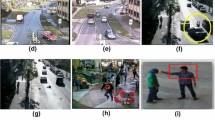Abstract
There are a number of solutions to automate the monotonous task of looking at a monitor to find suspicious behaviors in video surveillance scenarios. Detecting strange objects and intruders, or tracking people and objects, is essential for surveillance and safety in crowded environments. The present work deals with the idea of jointly modeling simple and complex behaviors to report local and global human activities in natural scenes. In order to validate our proposal we have performed some tests with some CAVIAR test cases. In this paper we show some relevant results for some study cases related to visual surveillance, namely “speed detection”, “position and direction analysis”, and “possible cashpoint holdup detection”.
Access this chapter
Tax calculation will be finalised at checkout
Purchases are for personal use only
Preview
Unable to display preview. Download preview PDF.
Similar content being viewed by others
References
Amer, A., Dubois, E., Mitiche, A.: Rule-based real-time detection of context-independent events in video shots. Real-Time Imaging 11(33), 244–256 (2005)
Andrade, E.L., Blunsden, S., Fisher, R.B.: Modelling crowd scenes for event detection. In: 18th International Conference on Pattern Recognition, vol. 1, pp. 175–178 (2006)
Blunsden, S., Fisher, R.B.: Pre-fight detection - Classification of fighting situations using hierarchical AdaBoost. In: Fourth International Conference on Computer Vision Theory and Applications, vol. 2, pp. 303–308 (2009)
Bobick, A.F., Davis, J.W.: The recognition of human movement using temporal templates. IEEE PAMI 23(3), 257–267 (2001)
Buxton, H., Gong, S.: Visual surveillance in a dynamic and uncertain world. Artificial Intelligence 78(1), 431–459 (1995)
Fernández-Caballero, A., López, M.T., Saiz-Valverde, S.: Dynamic Stereoscopic Selective Visual Attention (DSSVA): Integrating motion and shape with depth in video segmentation. ESWA 34(2), 1394–1402 (2008)
Fernández-Caballero, A., Gómez, F.J., López-López, J.: Road-traffic monitoring by knowledge-driven static and dynamic image analysis. ESWA 35(3), 701–719 (2008)
Galata, A., Johnson, N., Hogg, D.: Learning variable-length Markov models of behavior. CVIU 81(3), 398–413 (2001)
Gascueña, J.M., Fernández-Caballero, A.: On the use of agent technology in intelligent, multi-sensory and distributed surveillance. In: KER (2009) (in press)
Gavrila, D.M.: The visual analysis of human movement: a survey. CVIU 73(1), 82–98 (1999)
Hongeng, S., Nevatia, R., Bremond, F.: Video-based event recognition: activity representation and probabilistic recognition methods. CVIU 96(2), 129–162 (2004)
Huang, K., Wang, S., Tan, T., Maybank, S.: Human behavior analysis based on a new motion descriptor. IEEE CirSysVideo 19(12), 1830–1840 (2009)
Ivanov, Y.A., Bobick, A.F.: Recognition of visual activities and interactions by stochastic parsing. IEEE PAMI 22(8), 852–872 (2000)
Laptev, I., Pérez, P.: Retrieving actions in movies. In: International Conference on Computer Vision, pp. 1–8 (2007)
Lavee, G., Rivlin, E., Rudzsky, M.: Understanding video events: a survey of methods for automatic interpretation of semantic occurrences in video. IEEE SMC-C 39(5), 489–504 (2009)
Loccoz, N.M., Bremond, F., Thonnat, M.: Recurrent Bayesian network for the recognition of human behaviors from video. In: 3rd International Conference on Computer Vision Systems, pp. 68–77 (2003)
López, M.T., Fernández-Caballero, A., Fernández, M.A., Mira, J., Delgado, A.E.: Dynamic visual attention model in image sequences. IMAVIS 25(5), 597–613 (2007)
López, M.T., Fernández-Caballero, A., Fernández, M.A., Mira, J., Delgado, A.E.: Motion features to enhance scene segmentation in active visual attention. Pattern Recognition Letters 27(5), 469–478 (2006)
López, M.T., Fernández-Caballero, A., Mira, J., Delgado, A.E., Fernández, M.A.: Algorithmic lateral inhibition method in dynamic and selective visual attention task: Application to moving objects detection and labelling. ESWA 31(3), 570–594 (2006)
López-Valles, J.M., Fernández, M.A., Fernández-Caballero, A.: Stereovision depth analysis by two-dimensional motion charge memories. Pattern Recognition Letters 28(1), 20–30 (2007)
Moreno-Garcia, J., Rodriguez-Benitez, L., Fernández-Caballero, A., López, M.T.: Video sequence motion tracking by fuzzification techniques. ASOC 10(1), 318–331 (2010)
Natarajan, P., Nevatia, R.: View and scale invariant action recognition using multiview shape-flow models. In: IEEE Computer Society Conference on Computer Vision and Pattern Recognition, pp. 1–8 (2008)
Neumann, B., Möller, R.: On scene interpretation with description logics. IMAVIS 26(1), 82–101 (2008)
Oliver, N.M., Horvitz, E.: A comparison of HMMs and dynamic Bayesian networks for recognizing office activities. User Modeling, 199-209 (2005)
Oliver, N.M., Rosario, B., Pentland, A.P.: A Bayesian computer system for modeling human interactions. IEEE PAMI 22(8), 831–843 (2000)
Shechtman, E., Irani, M.: Matching local self-similarities across images and videos. In: IEEE Conference on Computer Vision and Pattern Recognition, pp. 1–8 (2007)
Tran, S.D., Davis, L.S.: Event modeling and recognition using Markov logic networks. In: Forsyth, D., Torr, P., Zisserman, A. (eds.) ECCV 2008, Part II. LNCS, vol. 5303, pp. 610–623. Springer, Heidelberg (2008)
Ulusoy, I., Bishop, C.M.: Generative versus discriminative methods for object recognition. In: The 2005 IEEE Computer Society Conference on Computer Vision and Pattern Recognition, vol. 2, pp. 258–265 (2005)
Wang, X., Ma, X., Grimson, W.E.L.: Unsupervised activity perception in crowded and complicated scenes using hierarchical Bayesian models. IEEE PAMI 31(3), 539–555 (2009)
Author information
Authors and Affiliations
Editor information
Editors and Affiliations
Rights and permissions
Copyright information
© 2010 Springer-Verlag Berlin Heidelberg
About this paper
Cite this paper
Fernández-Caballero, A., Castillo, J.C., Rodríguez-Sánchez, J.M. (2010). A Proposal for Local and Global Human Activities Identification. In: Perales, F.J., Fisher, R.B. (eds) Articulated Motion and Deformable Objects. AMDO 2010. Lecture Notes in Computer Science, vol 6169. Springer, Berlin, Heidelberg. https://doi.org/10.1007/978-3-642-14061-7_8
Download citation
DOI: https://doi.org/10.1007/978-3-642-14061-7_8
Publisher Name: Springer, Berlin, Heidelberg
Print ISBN: 978-3-642-14060-0
Online ISBN: 978-3-642-14061-7
eBook Packages: Computer ScienceComputer Science (R0)




